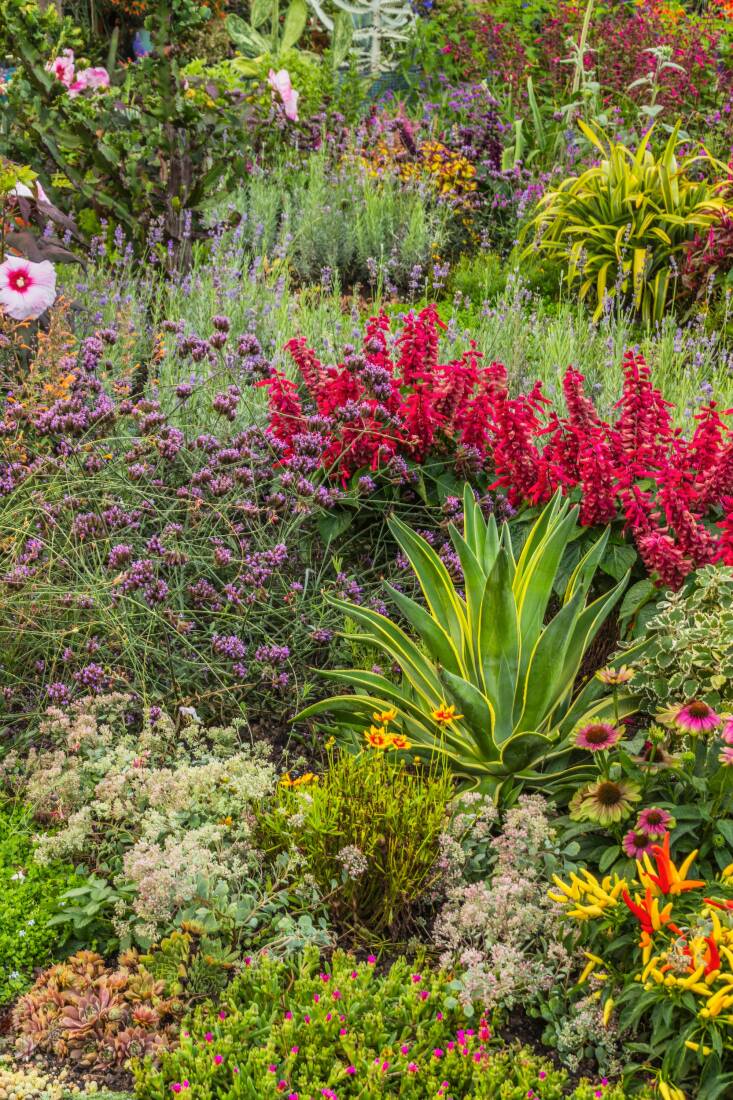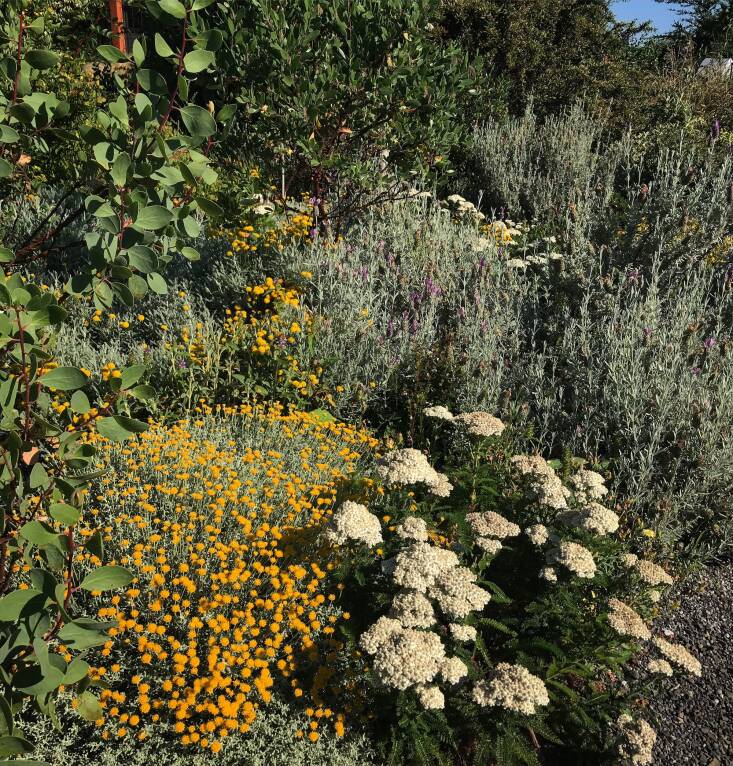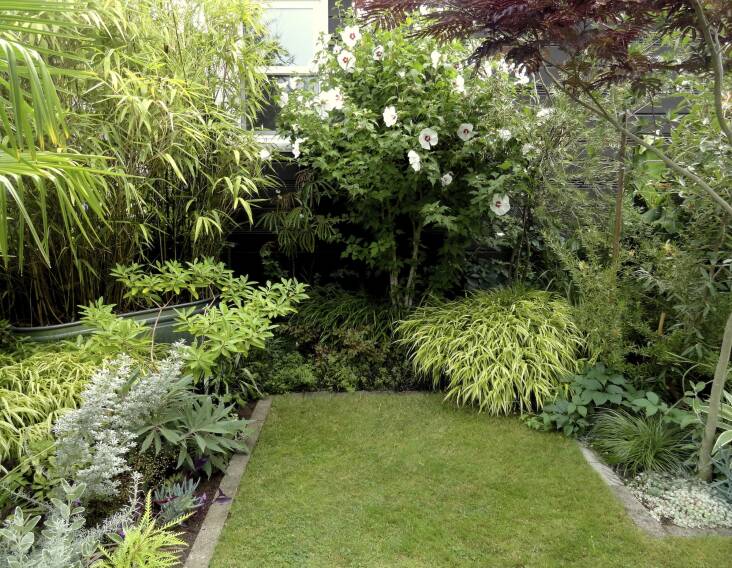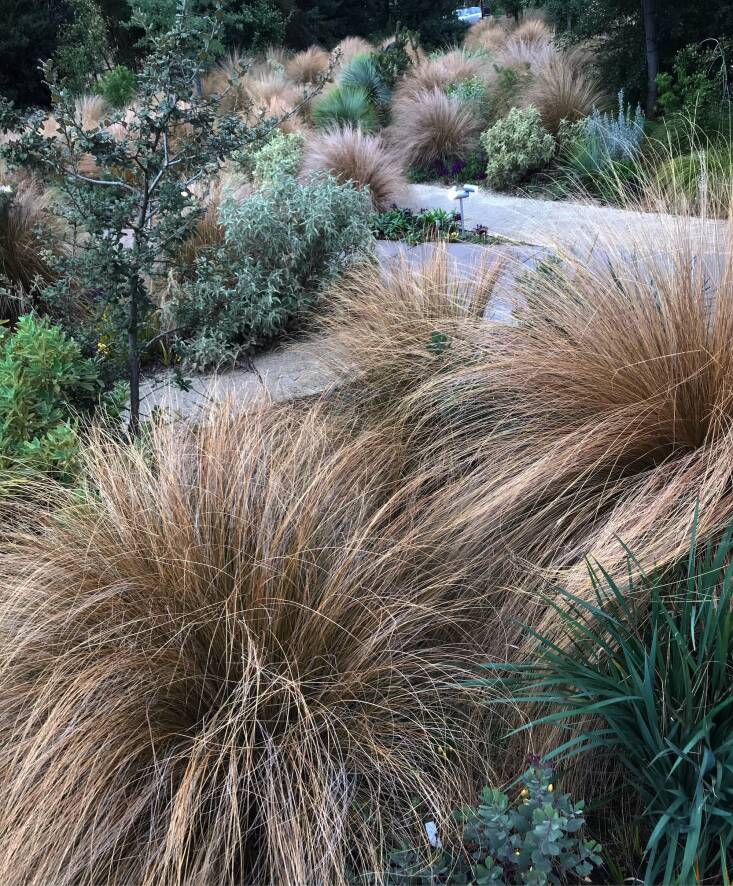When I put a call out to my garden design friends about the topic of “cramscaping,” I received a lot of replies along the lines of, “I have never heard of cramscaping, but I suspect I do it” or “I had no idea this was a thing, but it’s what I practice on a regular basis.” The concept had recently been covered in The Seattle Times, and I was curious to discover its origins.
I ultimately found a reference to “cramscaping” in Loree Boh’s book Fearless Gardening: Be Bold, Break the Rules, and Grow What You Love, which was published in 2021. When I called Bohl, who also writes the popular blog Danger Garden, Bohl said she didn’t coin the term, but she recalls the first time she heard a garden style described as “cramscaping.” Bohl was walking the Northwest Flower & Garden Show with a friend, who used the term to describe the display they were looking at. “It instantly just made sense to me,” says Bohl. “It says it all: Lots of plants.” When Bohl asked her friend about the term, she pointed to their mutual friend, plantsman and garden designer Sean Hogan of Cistus Nursery.
Next, I reached out to Hogan to see if he knew the term’s provenance. Hogan told me he wasn’t sure if he originated the phrase, but it has been in his personal lexicon since the 1990s. Hogan remembers first using it to describe a container that was planted so densely and with such variety that he likened it to a bouquet. From there, he started using the word to describe landscapes in general. “If you can have a quick phrase or a fun just word to give people a different picture, it allows people to think outside the boxwood, as it were,” he says.
So what is cramscaping exactly?
Above: After years of cramscaping, Bohl now sits in her Portland garden completely surrounded by plants. “It’s a wonderful feeling,” she says. “There are so many more plants I want to grow, I must make space for them and keep experimenting.” Photograph by Loree Bohl.
Both Bohl and Hogan define a cramscape as richly layered with a variety of plants and no bare earth visible. The term may be instantly understandable, but Bohl is quick to point out that cramscaping is not simply squeezing as many plants as possible into a landscape. “Cramscaping is done with a little more care and knowledge of eventual plant sizes and plant needs,” she explains, noting that without this foresight, an extra densely planted garden can be “a disaster waiting to happen.”
What’s the difference between cramscaping and matrix planting?
 Above: A cramscape tends to have a loose, naturalistic garden design style. Photograph by Sean Hogan.
Above: A cramscape tends to have a loose, naturalistic garden design style. Photograph by Sean Hogan.
If cramscaping sounds a lot like matrix planting, you’re not wrong. Bohl says she would consider matrix planting a more formally planned form of cramscaping. “I think of cramscaping as being less organized, more a ‘there’s always room for one more plant’-style of gardening,” she says. So, matrix planting could technically be considered cramscaping, but not all cramscaping is matrix planting.
Hogan believes a true cramscrape includes vignettes and intentional seasonal interest. “Every so often, you want areas that are more intense,” he says. Think: higher density and higher diversity. “These are areas to linger, maybe by a bench or just where it’s a good area you would stop,” he adds. A cramscape must have seasonal variety, too, noting, “It’s important that any day of the year you’re looking at your garden, you’re entertained.”
Why is cramscaping trending?
 Above: Featured in Garden to the Max, Jared and Liz Hughes’s garden in Marengo, Ohio, is a place to trial many annuals and perennials for the couple’s garden center Groovy Plants Ranch. Among the plants pictured here: salvia, lavender, coreopsis, and agastache. Photograph by Bob Stefko.
Above: Featured in Garden to the Max, Jared and Liz Hughes’s garden in Marengo, Ohio, is a place to trial many annuals and perennials for the couple’s garden center Groovy Plants Ranch. Among the plants pictured here: salvia, lavender, coreopsis, and agastache. Photograph by Bob Stefko.
Bohl primarily attributes the rise of cramscaping to, “gardeners who live on a standard city lot or a small piece of property with a desire to grow all the cool plants.” Hogan notes that it may have emerged in the Bay Area and Pacific Northwest because gardeners can grow such a wide variety of plants in those climates. However, cramscaping also aligns with several trends afoot in the garden world today.
A dense planting style aligns with the overall trend towards more naturalistic gardens. “It’s kind of how plants naturally grow,” says Bohl. “You don’t have a big void in nature: There’s the layers of the ground playing, and then the different heights of plants and shrubs up to trees. It’s a very natural way of planting.”
Teresa Woodward, the author of Garden to the Max, sees parallels with the trend of maximalism in the garden. “Cramscaping has a lot of the same themes that I was finding in this maximalist style,” she says. “Layering textures, colors, and forms and planting densely for abundance.”
What are the benefits of cramscaping?
 Above: Hogan snapped this photo of a Mediterranean cramscape he designed during the unprecedented 2021 heatwave in the Pacific Northwest. The temperature was 121 degrees. It reveals how dense planting leads to happier plants. Photograph by Sean Hogan.
Above: Hogan snapped this photo of a Mediterranean cramscape he designed during the unprecedented 2021 heatwave in the Pacific Northwest. The temperature was 121 degrees. It reveals how dense planting leads to happier plants. Photograph by Sean Hogan.
Beyond the visual delights of a lush, plant-filled garden, cramscaping offers several benefits to gardeners.
- Built-in biodiversity: A hallmark of cramscaping is a variety of plants, which fosters biodiversity. “The more different kinds of plants we have, the more insects and wildlife that we can support in our own backyards,” says Woodard.
- Less watering: Bohl says that many people might think more plants require more water, but the opposite is true. “Through choosing the right plants and cramscaping, so that there is that community of plants, you don’t end up watering more,” explains Bohl. “Because you’ve got all the planting layers and the sun isn’t hitting the soil, it doesn’t dry out as quickly.”
- Weed suppression: As Woodard points out, “if you plant densely, there’s less room for weeds.” Bohl adds that you won’t have to mulch to keep down weeds, if your plants cover all the soil.
- Error-friendly environment: Bohl loves that she can decide she’s done with the plant or a plant can die and she is not left with this gaping hole in her landscape. “Something else is there, ready to step in and fill the space,” she says.
How do you design your own cramscape?
 Above: Bohl says her lawn has steadily been shrinking as the planting beds have been growing. Photograph by Loree Bohl.
Above: Bohl says her lawn has steadily been shrinking as the planting beds have been growing. Photograph by Loree Bohl.
Cramscaping is a loose style of planting: If you want to try it out, you can start adding more plants wherever you see some soil peeking through. Bohl and Woodard offer some tips for how to make it a successful design:
- Copy nature: “Look to nature as a guide,” says Woodard. “You’ll find that plants thrive in community.” She encourages people to go on a hike and observe how plants grow in nature and emulate that a bit in their own planting.
- Plant in clusters: There’s nothing wrong with a garden that’s a little “one-of-each-y,” but as you layer in more plants, clusters of a single type of plant can help with legibility. “It helps move the eye because you have this color movement throughout the bed,” says Woodard.
- Leverage annuals: If you’ve got lots of gaps between young perennials, you can fill the gaps with annuals. “Annuals are a great way for quick impact so you can have a really abundant garden in one season,” says Woodard.
- Sow some seeds: One of the simplest ways to eliminate bare patches is to sow some annual seeds. If you’re okay with a little unpredictability, Woodard suggests choosing a kind that will self-seed, like nigella, larkspur, cleome, and cosmos. “These will give you another layer of color, and then at the end of the season, they’ll drop seed and you’ll have new plants then the next year,” she says. (See The Best Flower Seeds to Sow in the Fall for a Spring Bloom.)
- Divide and conquer: Both Bohl and Woodard point to divisions as a great way to get a more full look in your garden without spending a fortune. Bohl also notes that getting cuttings and divisions from friends and attending plant swaps can also help you fill the gaps economically. (See Time to Thin Out the Garden? How to Divide (and Multiply) Popular Perennials.)
 Above: Left uncut, grasses offer seasonal interest in this meadowscape garden designed by Hogan for a commercial client. Photograph by Sean Hogan.
Above: Left uncut, grasses offer seasonal interest in this meadowscape garden designed by Hogan for a commercial client. Photograph by Sean Hogan.
- Think in seasons: Following Hogan’s prescription for year-round entertainment, be strategic about seasonal bursts of color and texture. “You might have spring bulbs that come up and then you have another layer of plants that shine in the summer, like grasses and some perennials, and then yet another layer that shines in the fall,” says Woodard. “You can really bring some beauty seasonally with this layering technique.”
- Leave a path: Bohl cautions that as you layer in more plants you don’t block yourself out of your beds. “Leaving yourself a path into the garden space is very important,” she says. “I tend towards spiky plants, and so it’s not just difficult, but sometimes it’s painful to work in between plants that you’ve planted very close together.”
- Don’t forget to edit: Cramscaping can be a good “lazy” way to garden, because it keeps the weeds from taking over and helps the soil retain moisture. But, “part of smart overplanting is knowing when it’s time to edit,” says Bohl.
See also:



